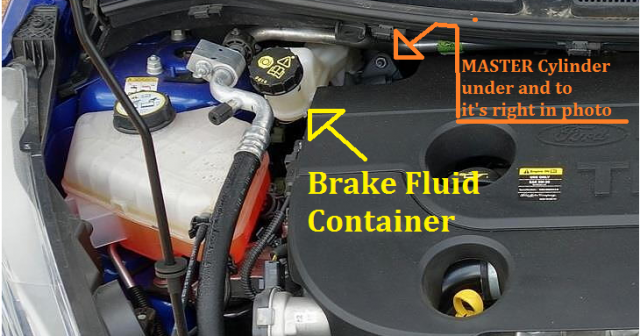In most cases - with a mechanics help, you can bleed down the brakes and find which system is plugged.
The Mechanic will know what to do, but usually how you bleed the system is when the car is at rest and parked on a level surface. IF on a hoist - you can remove the wheels to help gain better access and movement so you can bleed down the brakes without too much effort or extra movement.
A small 3/16" or 4mm I.D. clear tubing usually works - you need a small 6" 15mm length of clear plastic tubing so it can fit snugly over the nipple and you can then curl it upwards - to let air escape the pocket inside the cylinder or calipers piston.
An 8mm or 7mm box wrench can be used to crack open the bleeder screw then reseat it - to close the orifice so the air you bled out doesn't leak back in.
The bleed process is pretty simple - if the brake pedal is out - all the way out - being at rest - start the car to ensure you have full vacuum instilled into the brake booster - this also helps to pull out or reseat the brake pedal to fully out extension at rest.
You do this to make sure the pedal is NOT pressing in. IF the pedal is not fully retracting - you lose vacuum and the plunger that works the master cylinder is also blocking ports you need to have open.
- In the USA we have the Petrol version - not the Diesel - so they may call what we would call the "booster" another name, like Accumulator - or power assist. IN either function - if the Assist is constantly engaged, the pushrod that operates from the brake pedal - may not be able to fully retract. If this is the condition - the brake system is starved for fluid. So you need to find out why the pushrod / brake master cylinder is not retracting - to release the brakes fluid pressure back into the reservoir that feeds both halves of the brake system - that heads off to the ABS and the ABS itself has a proportioning system and Traction control using the Wheel speed sensors to handle the braking.
So you'll need to make sure the brake pedal can return to full back - at rest - position.
If you don't have that type of action - check the switches and paddles at the brake pedal - under the kickpanel trim - to make sure the system is not applying pressure or cannot fully retract the pushrod out of the master cylinder - preventing the braking system from replenishing fluid into the system from its reservoir - adjust as necessary and you can also verify the brake light operation is also working.
You can then install the tubing - snugly with its curl upwards - and crack open the bleeder screw so you can see fluid or bubbles in the clear tubing - once fluid begins to show solid fluid not foam or air pockets - you can then retighten the bleeder screw - remove the hose - install the dust cap and move onto the next one.
The above is what the mechanic will do, might as well watch so you can develop your own technique for the next time this might happen.
The key clue here is to keep the brake pedal pulled out and the brakes own pushrod is not engaging the master cylinder - the ports inside the master cylinder are then fully opened to let brake fluid from those upper cups - drain into it's own dual piston system and tubing to get thru to the ABS then onto the wheel cylinder (Drum) and the Calipers piston (Front Rotor) or both systems may use a Rotor / Piston system - with either setup - the ports back at the master cylinder need to be fully open to let the fluid drain down and by that reservoirs fluid capacity - it applies enough pressure to push fluid into the system (ABS system is released) to the calipers and drums - if so equipped.

